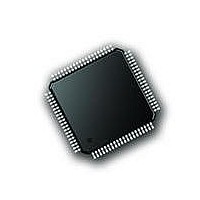PIC18F87J72-I/PT Microchip Technology, PIC18F87J72-I/PT Datasheet - Page 105

PIC18F87J72-I/PT
Manufacturer Part Number
PIC18F87J72-I/PT
Description
IC PIC MCU 8BIT 14KB FLSH 80TQFP
Manufacturer
Microchip Technology
Series
PIC® 18Fr
Datasheet
1.PIC18F86J72-IPT.pdf
(480 pages)
Specifications of PIC18F87J72-I/PT
Program Memory Type
FLASH
Program Memory Size
128KB (64K x 16)
Package / Case
80-TQFP
Core Processor
PIC
Core Size
8-Bit
Speed
48MHz
Connectivity
I²C, LIN, SPI, UART/USART
Peripherals
Brown-out Detect/Reset, LCD, LVD, POR, PWM, WDT
Number Of I /o
51
Ram Size
3.8K x 8
Voltage - Supply (vcc/vdd)
2 V ~ 3.6 V
Data Converters
A/D 12x12b
Oscillator Type
Internal
Operating Temperature
-40°C ~ 85°C
Data Bus Width
8 bit
Data Ram Size
4 KB
Interface Type
SPI, USART, SPI, I2C
Maximum Clock Frequency
8 MHz
Number Of Programmable I/os
51
Number Of Timers
4
Operating Supply Voltage
2 V to 3.6 V
Maximum Operating Temperature
+ 85 C
Mounting Style
SMD/SMT
Minimum Operating Temperature
- 40 C
On-chip Adc
14
Controller Family/series
PIC18F
No. Of I/o's
51
Ram Memory Size
3923Byte
Cpu Speed
48MHz
No. Of Timers
4
Rohs Compliant
Yes
Lead Free Status / RoHS Status
Lead free / RoHS Compliant
Lead Free Status / RoHS Status
Lead free / RoHS Compliant, Lead free / RoHS Compliant
Available stocks
Company
Part Number
Manufacturer
Quantity
Price
Company:
Part Number:
PIC18F87J72-I/PT
Manufacturer:
Microchip
Quantity:
210
Company:
Part Number:
PIC18F87J72-I/PT
Manufacturer:
Microchip Technology
Quantity:
10 000
- Current page: 105 of 480
- Download datasheet (5Mb)
10.0
Depending on the features enabled, there are up to
seven ports available. Some pins of the I/O ports are
multiplexed with an alternate function from the
peripheral features on the device. In general, when a
peripheral is enabled, that pin may not be used as a
general purpose I/O pin.
Each port has three memory mapped registers for its
operation:
• TRIS register (Data Direction register)
• PORT register (reads the levels on the pins of the
• LAT register (Output Latch register)
Reading the PORT register reads the current status of
the pins, whereas writing to the PORT register, writes
to the Output Latch (LAT) register.
Setting a TRIS bit (= 1) makes the corresponding
PORT pin an input (i.e., put the corresponding output
driver in a high-impedance mode). Clearing a TRIS bit
(= 0) makes the corresponding PORT pin an output
(i.e., put the contents of the corresponding LAT bit on
the selected pin).
The Output Latch (LAT register) is useful for
read-modify-write operations on the value that the I/O
pins are driving. Read-modify-write operations on the
LAT register read and write the latched output value for
the PORT register.
A simplified model of a generic I/O port, without the
interfaces to other peripherals, is shown in Figure 10-1.
FIGURE 10-1:
2010 Microchip Technology Inc.
device)
RD LAT
Data
Bus
WR LAT
or PORT
WR TRIS
RD TRIS
RD PORT
I/O PORTS
TRIS Latch
Data Latch
CKx
CKx
D
D
GENERIC I/O PORT
OPERATION
Q
Q
Q
EN
EN
D
Buffer
I/O Pin
Input
Preliminary
PIC18F87J72 FAMILY
10.1
When developing an application, the capabilities of the
port pins must be considered. Outputs on some pins
have higher output drive strength than others. Similarly,
some pins can tolerate higher than V
10.1.1
The voltage tolerance of pins used as device inputs is
dependent on the pin’s input function. Most of the pins
that are used as digital only inputs are able to handle DC
voltages up to 5.5V, a level typical for digital logic circuits.
In contrast, pins that also have analog input functions of
any kind can only tolerate voltages up to V
summarizes the input voltage capabilities of the I/O pins.
Refer to Section 29.0 “Electrical Characteristics” for
more details. Voltage excursions beyond V
pins should be avoided.
TABLE 10-1:
10.1.2
When used as digital I/O, the output pin drive strengths
vary for groups of pins intended to meet the needs for
a variety of applications. In general, there are three
classes of output pins in terms of drive capability.
PORTB and PORTC, as well as PORTA<7:6>, are
designed to drive higher current loads, such as LEDs.
PORTD, PORTE and PORTJ can also drive LEDs but
only those with smaller current requirements. PORTF,
PORTG and PORTH, along with PORTA<5:0>, have
the lowest drive level but are capable of driving normal
digital circuit loads with a high input impedance.
Regardless of which port it is located on, all output pins
in LCD Segment or common-mode have sufficient
output to directly drive a display.
Table 10-2 summarizes the output capabilities of the
ports. Refer to the “Absolute Maximum Ratings” in
Section 29.0 “Electrical Characteristics” for more
details.
PORTA<7:0>
PORTC<1:0>
PORTF<1,0>
PORTF<7:1>
PORTG<3:2, 0>
PORTB<7:0>
PORTC<7:2>
PORTD<7:0>
PORTE<7:2>
PORTG<4,1>
PORT or Pin
I/O Port Pin Capabilities
INPUT PINS AND VOLTAGE
CONSIDERATIONS
PIN OUTPUT DRIVE
INPUT VOLTAGE TOLERANCE
Tolerated
Input
5.5V
V
DD
Only V
tolerated.
Tolerates input
levels above V
useful for most
standard logic.
DS39979A-page 105
Description
DD
DD
input levels.
DD
input levels
DD
. Table 10-1
on these
DD
,
Related parts for PIC18F87J72-I/PT
Image
Part Number
Description
Manufacturer
Datasheet
Request
R

Part Number:
Description:
Manufacturer:
Microchip Technology Inc.
Datasheet:

Part Number:
Description:
Manufacturer:
Microchip Technology Inc.
Datasheet:

Part Number:
Description:
Manufacturer:
Microchip Technology Inc.
Datasheet:

Part Number:
Description:
Manufacturer:
Microchip Technology Inc.
Datasheet:

Part Number:
Description:
Manufacturer:
Microchip Technology Inc.
Datasheet:

Part Number:
Description:
Manufacturer:
Microchip Technology Inc.
Datasheet:

Part Number:
Description:
Manufacturer:
Microchip Technology Inc.
Datasheet:

Part Number:
Description:
Manufacturer:
Microchip Technology Inc.
Datasheet:











